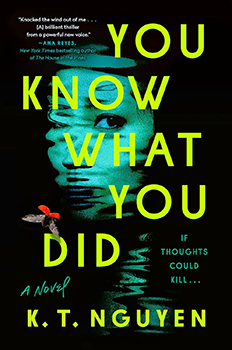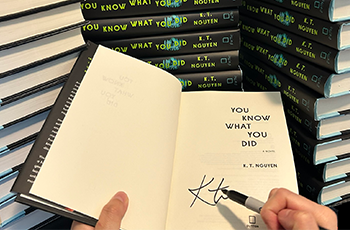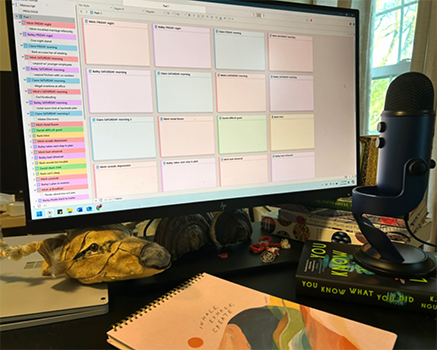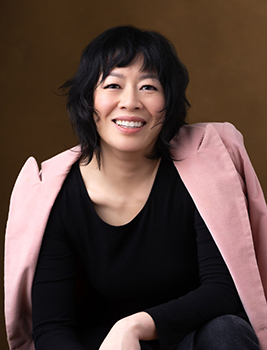

Features K.T. Nguyen
Slipping Into Madness
The Big Thrill Interviews Debut Author K.T. Nguyen
 YOU KNOW WHAT YOU DID, the debut novel by K.T. Nguyen, is the twistiest of twisty domestic suspense. Annie’s (Anh Le) reality is a slippery thing as she struggles with OCD and the death of her mother. Immigrants who fled Viet Nam had a fraught and toxic co-dependent relationship. Annie wrestles with the feelings of relief mingled with her grief. She also wrestles with a daughter bursting to stretch her newly teenaged wings and a supportive husband desperate for Annie to simply “let go” of her toxic past.
YOU KNOW WHAT YOU DID, the debut novel by K.T. Nguyen, is the twistiest of twisty domestic suspense. Annie’s (Anh Le) reality is a slippery thing as she struggles with OCD and the death of her mother. Immigrants who fled Viet Nam had a fraught and toxic co-dependent relationship. Annie wrestles with the feelings of relief mingled with her grief. She also wrestles with a daughter bursting to stretch her newly teenaged wings and a supportive husband desperate for Annie to simply “let go” of her toxic past.
Annie’s art is her one refuge. Byrdie, an elderly benefactor, encourages and financially supports Annie, and people are finally noticing her. Byrdie has even commissioned Annie to paint a major mural that will catapult her career into the limelight.
But when Byrdie disappears under mysterious circumstances, Annie’s sure something awful has happened. However, the police are less sure, especially since Annie’s confusion and doubt is growing as invisible threats come from every direction.
Readers experience Annie’s confusion and panic while still being beautifully grounded in the mystery. YOU KNOW WHAT YOU DID has some of the same qualities of following a person into madness as Steven King’s The Shining. And the ending is just as explosive.
The Big Thrill was pleased to sit down with Nguyen to talk about mental health, the bond between mothers and daughters, and the myth of being a “model minority.”
Where did the idea for YOU KNOW WHAT YOU DID come from?
One of the things I’m most proud of with this story is the portrayal of Obsessive Compulsive Disorder (OCD) and the mental health aspect of Annie’s story. I have OCD, and it’s very well controlled with medication. But when I set out to write a story, I had just listened to, for a second time, Stephen King’s On Writing. He says many of his stories start with the question, What If?
I was walking my dog, trying to think of a story, and I thought, “What if my intrusive thoughts—the worst ones—came to life?” That gives this story a bit of a horror vibe because OCD is called ‘the doubting disease’—you really do doubt your reality. You wonder, did I touch that? Did I not touch that? Did I wash this? Did I not wash this?
This is the part of YOU KNOW WHAT YOU DID (YKWYD) that has been widely well-received. Readers feel like they’re getting a good picture of OCD and a better appreciation of it than they had before. Because, as Annie says in the book, the portrayals on TV are usually lighthearted. Like Monk. But it’s incredibly crippling, and people don’t realize that. I’m hoping the book will give people a better understanding.
We follow Annie on her spiral into madness, yet you keep us grounded in the mystery surrounding her. How did you walk this storytelling tightrope?
As with any unreliable narrator story, you have questions. You don’t really know what to believe and what not to believe. But, because the story is so grounded in Annie’s perspective, I thought if I clearly conveyed her experience, then you’d see how the mystery is really unfolding. It’s about showing the character’s story. To me, the character is the most important thing.

K.T. Signing Books
YOU KNOW WHAT YOU DID is a story of mothers and daughters. Annie and her mother have a special bond, which seems to suffocate Annie—she isn’t able to escape even after her mother’s death. When creating Annie and her mother, did you form them separately, or did you have to create them as a unit?
The mother-daughter story was an integral part of YKWYD from the beginning. I knew I wanted to write a character-driven mystery. When I started writing, it had been only a few months since my father passed away, and all these raw emotions and feelings of grief came out.
It’s the mother-daughter bond and suffering grief from death that provides the impetus for the book. The nature of their relationship—the friction and the tension—is a huge part of the story.
This friction is common in first-generation immigrant families. Children, because they pick up the language more quickly, have the responsibility of helping their parents, who are rendered almost helpless. They’re like a child because they don’t know the language, but their actual child ends up having to help them navigate the world. It’s a lot of responsibility, and it’s very common.
You talk about the pressures and myths of being a “model minority” as inspiring the themes in your writing. Can you share more about this?
One trope you’ll find in YOU KNOW WHAT YOU DID and other domestic suspense is how everything looks perfect on the outside, but on the inside, it’s very messy. It’s a common kind of trope in domestic suspense because it gives us the chance to look inside people’s homes and see what’s really going on.
“Model minority” fits into this trope because you’re expected to achieve at a certain level and be better than your peers in terms of grades and accomplishments, but inside you’re dealing with all these messy issues you’re not supposed to talk about. Even kids and adults who aren’t members of a model minority are pressured to achieve at certain levels these days and keep up a social media façade, so I think a lot of people can relate to that. It’s those kinds of themes I’ll continue to weave into my stories.

K.T.’s Workspace
How did your time as a magazine editor inform your thriller writing?
I was a beauty editor, but I also did some celebrity interviews. Like minor celebrities—makeup artists and fashion stylists. One thing I think I excelled at as an editor at Glamour was interviewing and telling people’s stories and experiences in a way that was digestible to readers. That’s why I’m so drawn to character-driven stories.
What’s next?
I just finished a short story that I’m really excited about. I’m also writing my second book, a psychological thriller that draws on my experience working in the beauty and fashion business.
The Big Thrill Interviews Debut Author K.T. Nguyen
- Caroline Cleveland - May 23, 2024
- Kim Hays - May 9, 2024
- Kara Thomas - April 25, 2024

